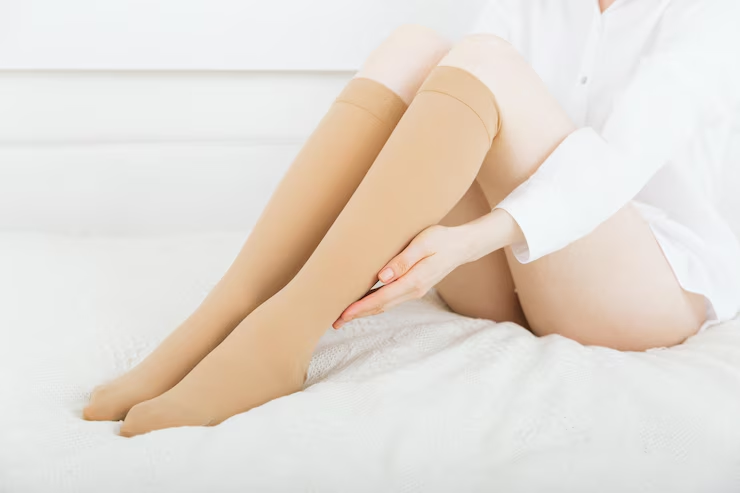Compression hosiery is more than just snug-fitting garments—it’s a medically beneficial solution for people managing various health conditions or seeking better leg comfort during daily routines.
Whether you’re on your feet all day, travelling long distances, or managing a medical condition like varicose veins or lymphoedema, choosing the right compression hosiery can make a significant difference to your comfort, circulation, and overall well-being.
But with a wide range of options available, how do you know which type is best suited to your needs? Let’s break it down.
What Is Compression Hosiery?
Compression hosiery includes socks, stockings, and tights that are designed to apply graduated pressure to the legs. This pressure helps improve blood flow, reduce swelling, and prevent the formation of blood clots, especially in individuals with venous disorders.
Typically, compression levels are measured in mmHg (millimetres of mercury). The higher the number, the stronger the compression.
Why Compression Hosiery Matters
According to the Australian and New Zealand Society for Vascular Surgery, up to 30% of Australians experience some form of chronic venous disease. Symptoms like aching, swelling, and varicose veins can be managed effectively with well-chosen compression garments.
Wearing the right compression hosiery can:
- Alleviate leg fatigue and heaviness
- Prevent and reduce swelling
- Improve venous return and circulation
- Minimise the risk of deep vein thrombosis (DVT)
- Enhance athletic recovery for active individuals
How to Choose the Right Pair
1. Identify Your Specific Needs
Start by understanding why you need compression hosiery. Common reasons include:
- Medical support for varicose veins, post-surgical recovery, or lymphoedema
- Travel comfort for long flights or road trips
- Occupational support for jobs that require long hours of standing
- Sports recovery for muscle fatigue or injury prevention
Each scenario may require a different compression level and style.
2. Know the Compression Levels
Compression hosiery is typically available in these ranges:
- Mild (8–15 mmHg): Ideal for daily use, travel, and mild discomfort
- Moderate (15–20 mmHg): Suitable for mild varicose veins and minor swelling
- Firm (20–30 mmHg): Recommended for moderate to severe varicose veins, swelling, and post-surgery
- Extra Firm (30–40 mmHg): Used under medical supervision for chronic conditions like lymphoedema
Tip: If you’re new to compression wear or buying it for a medical condition, it’s wise to consult a healthcare provider.
3. Select the Right Style
Compression hosiery comes in different styles:
- Knee-high: Easiest to wear, ideal for swelling below the knee
- Thigh-high: Offers extended support; good for swelling above the knee
- Pantyhose or tights: Best for full-leg support or pregnancy-related issues
Dick Wicks offers styles that blend therapeutic compression with modern designs and breathable fabrics, ensuring both function and comfort.
4. Focus on Fit and Fabric
Improper fit can reduce the effectiveness of compression hosiery. Always measure your leg circumference and length based on the size chart provided. Choose fabrics that are:
- Breathable and moisture-wicking for all-day comfort
- Durable and elastic to maintain consistent pressure
- Latex-free to avoid allergic reactions
5. Ease of Use
Look for designs that are easy to put on and take off. Compression hosiery with a graduated compression profile and reinforced toe or heel areas offers better durability and support.
Caring for Your Compression Hosiery
To maintain the elasticity and hygiene of your hosiery:
- Hand wash or use a gentle machine cycle
- Avoid using fabric softeners
- Air dry instead of tumble drying
- Replace every 3–6 months, depending on wear frequency
More Than Just Hosiery
At Dick Wicks, health and comfort go beyond compression garments. Explore our jewellery with magnets for a natural boost to wellbeing, and unwind with our magnetic bedding—designed to support deep, restorative sleep through magnetic therapy.
Ready to Find the Perfect Fit?
Compression hosiery can significantly improve your quality of life—but only if chosen thoughtfully. Whether you’re seeking daily support or managing a chronic condition, Dick Wicks offers a trusted range of therapeutic solutions backed by decades of expertise.
Explore our compression hosiery collection today and experience the difference comfort can make.
Have you tried compression hosiery before? What changes did you notice in your day-to-day comfort?
FAQs
How long should I wear compression hosiery each day?
It depends on your needs. For daily use or travel, 6–8 hours is typical. For medical use, follow your doctor’s advice.
Can I wear compression hosiery while sleeping?
Unless prescribed for specific medical conditions, it’s best to remove them while sleeping to allow your skin to breathe.
Are there side effects to using compression hosiery?
If fitted incorrectly, they may cause discomfort or skin irritation. Always ensure the proper size and compression level.
Is compression hosiery effective for pregnancy-related swelling?
Yes. Maternity compression stockings can reduce leg swelling and discomfort during pregnancy. Choose options designed specifically for maternity support.
How do I know when to replace my compression hosiery?
Signs include loss of elasticity, sagging, or visible wear. Typically, every 3–6 months is a good replacement interval.
Enjoyed this? Share this post with fellow fans and influencers, and be sure to check back regularly for the latest updates, insights, and news on all things simpcity!
